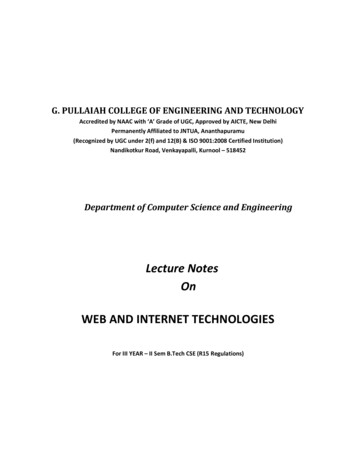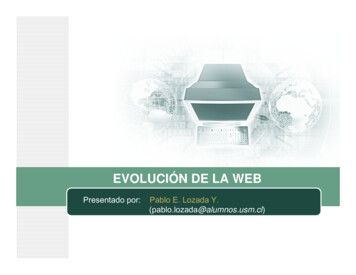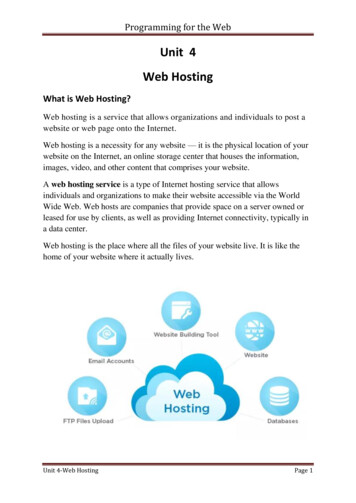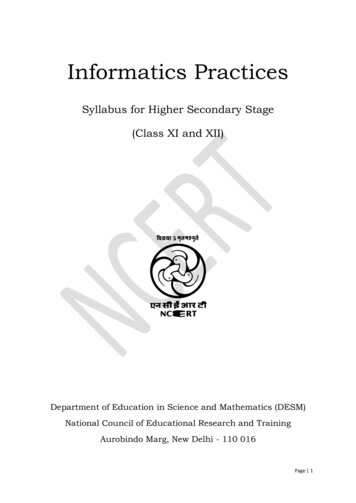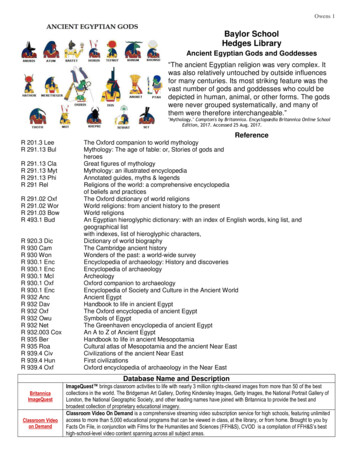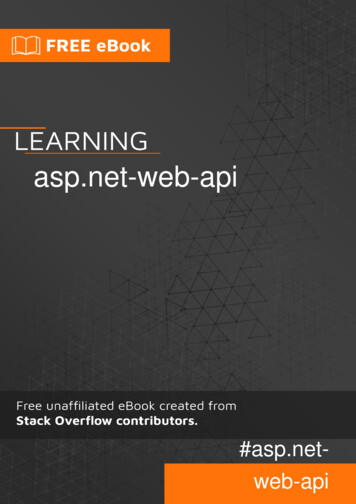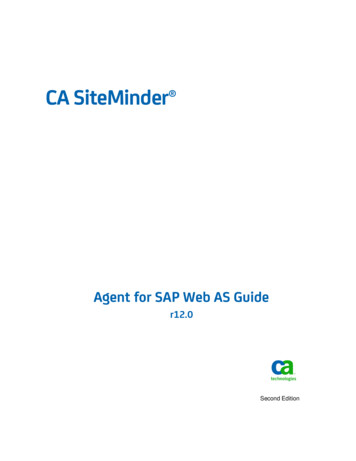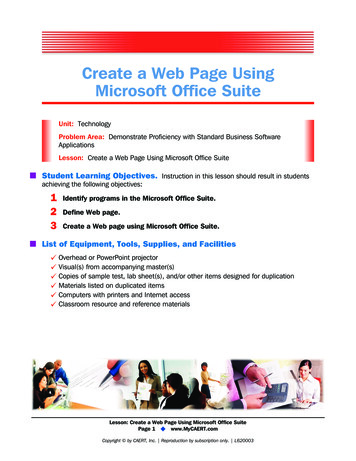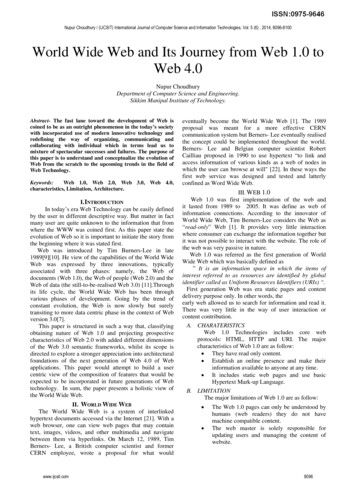
Transcription
Nupur Choudhury / (IJCSIT) International Journal of Computer Science and Information Technologies, Vol. 5 (6) , 2014, 8096-8100World Wide Web and Its Journey from Web 1.0 toWeb 4.0Nupur ChoudhuryDepartment of Computer Science and Engineering.Sikkim Manipal Institute of Technology.Abstract- The fast lane toward the development of Web iscoined to be as an outright phenomenon in the today’s societywith incorporated use of modern innovative technology andredefining the way of organizing, communicating andcollaborating with individual which in terms lead us tomixture of spectacular successes and failures. The purpose ofthis paper is to understand and conceptualize the evolution ofWeb from the scratch to the upcoming trends in the field ofWeb Technology.Keywords:Web 1.0, Web 2.0, Web 3.0, Web 4.0,characteristics, Limitation, Architecture.I. INTRODUCTIONIn today’s era Web Technology can be easily definedby the user in different descriptive way. But matter in factmany user are quite unknown to the information that fromwhere the WWW was coined first. As this paper state theevolution of Web so it is important to initiate the story fromthe beginning where it was stated first.Web was introduced by Tim Burners-Lee in late1989[9][10]. He view of the capabilities of the World WideWeb was expressed by three innovations, typicallyassociated with three phases: namely, the Web ofdocuments (Web 1.0), the Web of people (Web 2.0) and theWeb of data (the still-to-be-realised Web 3.0) [11].Throughits life cycle, the World Wide Web has been throughvarious phases of development. Going by the trend ofconstant evolution, the Web is now slowly but surelytransiting to more data centric phase in the context of Webversion 3.0[7].This paper is structured in such a way that, classifyingobtaining nature of Web 1.0 and projecting prospectivecharacteristics of Web 2.0 with added different dimensionsof the Web 3.0 semantic frameworks, whilst its scope isdirected to explore a stronger appreciation into architecturalfoundations of the next generation of Web 4.0 of Webapplications. This paper would attempt to build a usercentric view of the composition of features that would beexpected to be incorporated in future generations of Webtechnology. In sum, the paper presents a holistic view ofthe World Wide Web.II. WORLD WIDE WEBThe World Wide Web is a system of interlinkedhypertext documents accessed via the Internet [21]. With aweb browser, one can view web pages that may containtext, images, videos, and other multimedia and navigatebetween them via hyperlinks. On March 12, 1989, TimBerners- Lee, a British computer scientist and formerCERN employee, wrote a proposal for what wouldwww.ijcsit.comeventually become the World Wide Web [1]. The 1989proposal was meant for a more effective CERNcommunication system but Berners- Lee eventually realisedthe concept could be implemented throughout the world.Berners- Lee and Belgian computer scientist RobertCailliau proposed in 1990 to use hypertext “to link andaccess information of various kinds as a web of nodes inwhich the user can browse at will" [22]. In these ways thefirst web service was designed and tested and latterlyconfined as Word Wide Web.III. WEB 1.0Web 1.0 was first implementation of the web andit lasted from 1989 to 2005. It was define as web ofinformation connections. According to the innovator ofWorld Wide Web, Tim Berners-Lee considers the Web as“read-only” Web [1]. It provides very little interactionwhere consumer can exchange the information together butit was not possible to interact with the website. The role ofthe web was very passive in nature.Web 1.0 was referred as the first generation of WorldWide Web which was basically defined as” It is an information space in which the items ofinterest referred to as resources are identified by globalidentifier called as Uniform Resources Identifiers (URIs) “.First generation Web was era static pages and contentdelivery purpose only. In other words, theearly web allowed us to search for information and read it.There was very little in the way of user interaction orcontent contribution.A. CHARATERISTICSWeb 1.0 Technologies includes core webprotocols: HTML, HTTP and URI. The majorcharacteristics of Web 1.0 are as follow: They have read only content. Establish an online presence and make theirinformation available to anyone at any time. It includes static web pages and use basicHypertext Mark-up Language.B. LIMITATIONThe major limitations of Web 1.0 are as follow: The Web 1.0 pages can only be understood byhumans (web readers) they do not havemachine compatible content.The web master is solely responsible forupdating users and managing the content ofwebsite.8096
Nupur Choudhury / (IJCSIT) International Journal of Computer Science and Information Technologies, Vol. 5 (6) , 2014, 8096-8100 Lack of Dynamic representation i.e., to acquireonly static information, no web console wereavailable to performing dynamic events.IV. WEB 2.0Web 2.0 is the second generation of web. It wasdefined by Dale Dougherty in 2004 as a read-write web [1].The concept began with a conference brainstorming sessionbetween O’Reilly and Media live International. Thetechnologies of web 2.0 allow assembling and managinglarge global crowds with common interests in socialinteractions.Tim O’Reilly defines web 2.0 on his website as follows[8]:“Web 2.0 is the business revolution in thecomputer industry caused by the move to theinternet as platform, and an attempt tounderstand the rules for success on that newplatform. Chief among those rules is this: Buildapplications that harness network effects to getbetter the more people use them.”Web 2.0 facilitates major properties like participatory,collaborative, and distributed practices which enable formaland in-formal spheres of daily activities on going on web.In other terms it resemble major distinct characteristics ofWeb 2.0 include “relationship” technologies, participatorymedia and a social digital technology which in term canalso defined as the wisdom web. People-centric web andparticipative web is taken into concern and which facilitiesreading and writing on the web which makes the webtransaction bi-directional.Web 2.0 is a web as a platform where users can leavemany of the controls they have used in web 2.0. In otherwords, the user of web 2.0 has more interaction with lesscontrol. Web 2.0 is not only a new version of web 1.0but it also implies to flexible web design, creative reuse,updates, collaborative content creation and modificationin web 2.0 that should be considered as one of theoutstanding feature of the web 2.0 is to supportcollaboration and to help gather collective intelligencerather Web 1.0.Fig. 1 Comparison Web1.0 & Web 2.0 [28]A. CHARATERISTICSWeb 2.0 is instead a label coined by Tim O’Reilly andassociates to reference the transition of the Worldwww.ijcsit.comWide Web to a new phase of use and servicedevelopment [17]. The categorization can be used toelaborate on the understanding of Web 2.0 achievedthrough varied definitions. Technology Centric Definition:Web has become a platform withsoftware above the level of a singledevice. Technology that is associatedwith blogs, wikis, podcasts, RSS feedsetc. Business Centric Definitions:A way of architecting software andbusinesses. The business revolution in thecomputer industry caused by the move tointernet as platform and an attempt tounderstand the rules for success on that ofnew platform. User Centric Definitions:The Social Web is often used tocharacterize sites that consist ofcommunities. It is all about contentmanagement and new ways ofcommunication and interaction betweenusers. Web applications that facilitatecollective knowledge production, socialnetworking and increases user to userinformation exchange.B. LIMITATIONSometimes it may happen that if the new technologymeets expectations of the mass user at large, there maybe a chance that these technologies may face lot ofconsequences from external environment which maysupress or limit the flow of technology in presentingresults which might not be feasible and may lead todegrade the performance of the technology as a whole. Constant iteration cycle of Change andUpdates to services [11].Ethical issues concerning build and usage ofWeb 2.0 [11].Interconnectivity and knowledge sharingbetween platforms across communityboundaries are still limited [12] [15].V. WEB 3.0Web 3.0 is one of modern and evolutionary topicsassociated with the following initiatives of Web 2.0. Web3.0 was first coined by John Markoff of the New YorkTimes and he suggested web 3.0 as third generation of theweb in 2006 [18]. Web 3.0 can be also stated as“executable Web”.The basic idea of web 3.0 is to define structure data andlink them in order to more effective discovery, automation,integration, and reuse across various applications [6]. It isable to improve data management, support accessibilityof mobile internet, simulate creativity and innovation,encourage factor of globalization phenomena, enhancecustomers’ satisfaction and help to organize collaborationin social web.8097
Nupur Choudhury / (IJCSIT) International Journal of Computer Science and Information Technologies, Vol. 5 (6) , 2014, 8096-8100Web 3.0 is also known as semantic web. Semantic webwas thought up by Tim Berners-Lee, inventor of the WorldWide Web [1]. There is a dedicated team at the WorldWide Web consortium(W3C) working to improve, extend and standardize thesystem, languages, publications and tools have alreadybeen developed [3]. Web 3.0 is a web where the concept ofwebsite or webpage disappears, where data isn’t owned butinstead shared, where services show different views for thesame web or the same data. Those services can beapplications (like browsers, virtual worlds or anythingelse), devices or other, and have to be focused on contextand personalization, and both will be reached by usingvertical search [13].Web3.0 supports world wide database and weboriented architecture which in earlier stage was describedas a web of document. It deals mainly with static HTMLdocuments, but dynamically rendered pages and alternativeformats should follow the same conceptual layout standardswhenever possible and links are between documents or partof them. The web of documents was designed for humanConsumption in which primary objects are documents andlinks are between documents (or parts of them). Semanticsof content and links are implicit and the degree of structurebetween objects is fairly low [19]. Figure 2 represents thestructure of web of documents in simple [19].A. SEMANTIC WEBThe Semantic Web is a collaborative movementled by international standards body the World WideWeb Consortium. According to the W3C [4],“The Semantic Web provides a commonframework that allows data to be shared and reusedacross application, enterprise, and communityboundaries “.The main purpose of the Semantic Web is drivingthe evolution of the current Web by enabling users tofind, share and combine in formation more easily. TheSemantic Web, as originally envisioned, is a system thatenables machines to “understand” and respond tocomplex human requests based on their meaning. Suchan “understanding” requires that the relevantinformation sources be semantically structured.Tim Berners- Lee originally expressed the SemanticWeb as follows [2]:“If HTML and the Web made all the onlinedocuments look like one huge book, RDF, schema, andinference languages will make all the data in the worldlook like one huge database”.Tim Berners-Lee proposed a layered architecturefor semantic web that often represented using adiagram, with many variations since.Fig. 2 Web of Document [20].The proponents of the Web of Data envision much ofthe world's data being interrelated and openly accessible tothe general public. This vision is analogous in many waysto the Web of Documents of common knowledge, butinstead of making documents and media openly accessible,the focus is on making data openly accessible, the Web ofData hosts a variety of data sets that includeencyclopaedic facts, drug and protein data, metadata onmusic, books and scholarly articles, social networkrepresentations, geospatial information, and many othertypes of information in some ways like a global databasethat most its features are included Semantics of content andlinks are explicit and the degree of structure betweenobjects is high based on RDF model. In Fig. 3, the structureof web of data is shown simplicity [14].Fig. 3 Web of Data [20].www.ijcsit.comFig. 4 Semantic Web layered architecture [5]The development of the Semantic Web proceeds insteps, each step building a layer on top of another.Figure 4 shows the “layer cake” of the Semantic Webwhich describes the main layers of the Semantic Webdesign and vision [5]. Unicode and URI: Unicode is used to representof any character uniquely whatever this characterwas written by any language and UniformResource Identifier (URI) is unique identifiersfor resources of all. The functionality of Unicodeand URI could be described as the provisionof a unique identification mechanism withinthe language stack for the semantic web [20]. XML: It is a language that lets one writestructured Web documents with a user-definedvocabulary. XML is particularly suitable forsending documents across the Web. XML has nobuilt-in mechanism to convey the meaning of theuser’s new tags to other users. RDF: Resource Description Framework is abasic data model, like the entity-relationshipmodel, for writing simple statements about Webobjects (resources). A scheme for defining8098
Nupur Choudhury / (IJCSIT) International Journal of Computer Science and Information Technologies, Vol. 5 (6) , 2014, 8096-8100information on the Web. RDF provides thetechnology for expressing the meaning of termsand concepts in a form that computers canreadily process. RDF Schema: It provides a predefined, basictype system for RDF models. RDF Schemaprovides modeling primitives for organizingWeb objects into hierarchies. Key primitives areclasses and properties, subclass and sub propertyrelationships, and domain and range restrictions. Ontology: The ontology layer describedproperties and the relation between propertiesand different. Ontology can be defined as acollection of terms used to describe a specificdomain with the ability of inference. Logic layer: It is used to enhance the ontologylanguage further and to allow the writing ofapplication-specific declarative knowledge. Proof layer: It involves the actual deductiveprocess as well as the representation of proofsin Web languages (from lower levels) andproof validation. Trust layer: It will emerge through the use ofdigital signatures and other kinds of knowledgebased on recommendations by trusted agents oron rating and certification agencies andconsumer bodies.Semantic web is not limited to publish data on theweb. It is about making links to connect related data.Berners-Lee introduced a set of rules have becomeknown as the Linked Data principles to publish andconnect data on the web in 2007 [16]: Use URIs as names for things Use HTTP URIs to look up those names Provide useful information, using thestandards (RDF) by look up a URI Include links to other URIs to discover morethingsData providers can add their data to a singleglobal data space by publishing data on the webaccording to the Linked Data principles.B. CHARACTERISTICSThe major characteristics of Web 3.0 as marked byNova Spivack are [18]: SaaS Business Model. Open Source Software Platform. Distributed Database –or what called as “TheWorld Wide Database”. Web Personalization. Resource Pooling Intelligent Web.C. CHALLENGESSemantic Web faces several challenging issuelike: Vastness: The World Wide Web containsmany billions of pages. Redundancy in Datamay occur which has not yet been able toeliminate all semantically duplicated terms.www.ijcsit.com Vagueness: This arises from the vagueness ofuser queries, of concepts represented bycontent providers, of matching query terms toprovider terms and of trying to combinedifferent knowledge bases with overlappingbut subtly different ns which will inevitably ariseduringthedevelopmentoflargeontologies, and when ontologies fromseparate sources are combined.Deceit: This is when the producer of theinformation is intentionally misleading theconsumer of the information.VI. COMPARISIONThe main difference between Web 1.0, Web 2.0 andWeb 3.0 is that web 1.0 is consider as read-only webtargets on content creativity of producer web 2.0 targetson content creativity of users and producers while web 3.0targets on linked data sets. The very few comparativedifferences between Web 1.0, Web 2.0 and Web 3.0 aregiven below:WEB 1.0WEB 2.0WEB 3.01996 – 20042004 -20162016 The HypertextThe Social WebThe Semantic WebWebTim BernersTim O’Reilly, DaleTim Berners LeeLeeDoughertyRead and WriteRead OnlyExecutable WebWebMillions ofBillions of UserTrillions of UsersUserParticipation andEcho SystemUnderstanding selfInteractionOneMulti-user VirtualBi-DirectionalDirectionalenvironmentPeople buildCompaniesapplication thoughPeople PublishPublishwhich peopleContentContentinteract andpublish content.Web 3.0 iscuriouslyStatic content. Dynamic content.undefined.AI and 3D,Theweb learningPersonalBlog and unity portals Semantic ForumsBoardBuddy List,Online SocialSemantic SocialAddress Book networks.InformationTable 1. Comparison of Web 1.0, Web 2.0 and Web 3.0VII. WEB 4.0 AND FUTURE WEBWeb 4.0 can be considered as an Ultra-IntelligentElectronic Agent, symbiotic web and Ubiquitous web[25]. Interaction between humans and machines in8099
Nupur Choudhury / (IJCSIT) International Journal of Computer Science and Information Technologies, Vol. 5 (6) , 2014, 8096-8100symbiosis was motive behind of the symbiotic web.Powerful as human brain, progress in the development oftelecommunications, advancement on nanotechnology inthe world and controlled interfaces using web 4.0. Insimple words, machines would be clever on reading thecontents of the web, and react in the form of executing anddeciding what to execute first to load the websites fast withsuperior quality and performance and build morecommanding interfaces [24].Web 4.0 will be read write concurrency web [23]. Itensures global transparency, governance, distribution,participation, collaboration into key communities such asindustry, political, social and other communities. WebOSwill be such as a middleware in which will start functioninglike an operating system [26]. WebOS will be parallel tothe human brain and implies a massive web of highlyintelligent interactions [27].VIII. CONCLUSIONThis paper provided an overview from the evolution ofthe web. Web 1.0, web 2.0, web 3.0 and web 4.0 weredescribed as four generations of the web. Thecharacteristics of the generations are introduced andcompared. It is concluded web as an information space hashad much progress since 1989 and it is moving towardusing artificial intelligent techniques to be as a massiveweb of highly intelligent interactions in close future.[1][2][3][4][5][6][7][8][9]REFERENCESTim Berners-Lee, “The World Wide Web: A very short personalhistory”, html ,1998.Berners-Lee, Tim; Fischetti, Mark,” Weaving the Web”, Harper SanFrancisco, chapter 12, ISBN 978-0-06-251587-2, 1999.Sean B, Palmer, “The Semantic Web: An Introduction”,http://infomesh.net/2001/swintro/, 2001.W3C Semantic Web Activity “http://www.w3.org/2001/sw/”, WorldWide Web Consortium, 2001.Jane, Greenberg & Stuart, Sutton & D. Grant, Campbell ,“Metadata: A Fundamental Component of the Semantic Web”,Bulletin of the American Society for Information Science andTechnology Volume 29, Issue 4, pages n/slide6-0.html, 2003.Motta, E., & Sabou, M, “Next Generation Semantic WebApplications”, Heidelberg, Springer-Verlag Berlin, pp. 24-29, n-tryi.html, 2006.Brian, Getting, “Basic Definitions: Web 1.0, Web 2.0, Web ww.ijcsit.com[10] Maged, N. Kamel Boulos & Steve, Wheeler, “The emerging Web2.0 social software: an enabling suite of sociable technologies inhealth and health care education”, Health Information and LibrariesJournal, pp: 2 -23, 2007[11] Anderson, P. ” All That Glisters Is Not Gold' -- Web 2.0 AndThe Librarian”, Journal of Librarianship and Information Science,39 (4), pp. 195–198, 2007.[12] Abel, F., Frank, M., Henze, N., Krause, D., Plappert, D., & Siehndel,P., “Group Me! - Where Semantic Web meets Web 2.0”, 2007.[13] l,2007.[14] Tim, Berners-Lee & Christian, Bizer & Tom, Heath & Kingsley,Idehen, “Linked Data on the Web”, 17th International World WideWeb Conference, 2008.[15] Chan, C. K., Lee, Y. C., & Lin, V., “Harnessing Web 2.0 forCollaborative Learning”, Springerlink, 2009.[16] Christian, Bizer & Tom, Heath & Tim, Berners-Lee, “LinkedData - The Story So Far”, Journal Semantic Web and InformationSystems, 2009.[17] Harrisom, T. M., & Barthel, B., “ Wielding new media in Web2.0: exploring the history of engagement with the collaborativeconstruction of media products ”. New media & Society, 11(1&2),pp. 155–178, 2009.[18] Nova Spivack, “Web 3.0: The Third Generation Web is Coming”http://lifeboat.com/ex/web.3.0, 2011.[19] Sareh Aghaei, Mohammad Ali Nematbakhsh and Hadi KhosraviFarsani, “Evolution of the World Wide Web: From Web 1.0 to Web4.0”,Computer Engineering Department, University of Isfahan,Isfahan, Iran, International Journal of Web & Semantic Technology(IJWesT) Vol.3, No.1,pp. 1-10, 2012[20] Patel et al., International Journal of Advanced Research in ComputerScience and Software Engineering 3(10), pp. 410-417, 2013.[21] W3C “World Wide Web Consortium”, http://www.w3.org.[22] World Wide Web: Proposal for a HyperText Project(http://www.w3.org/Proposal.html).[23] “Web 4.0 - A New Web Technology”, new-webtechnology.html/,Hemnath (2010)[24] On2broker: Lessons Learned from Applying AI to the Web DieterFensel, Jürgen Angele, Stefan Decker, Michael Erdmann, HansPeter Schnurr, Rudi Studer and Andreas Witt Institute AIFB,UniversityofKarlsruhe,D -76128 Karlsruhe, ni-karlsruhe.de/ dfe.[25] JONATHAN FOWLER AND ELIZABETH RODD(2013) igentelectronic-agent-is-coming.[26] Ron, Callari , “Web 4.0,Trip Down the Rabbit Hole or BraveNew World?”, -hole-or-brave-new-world/ .[27] Dan, Farber (2007), “From semantic Web (3.0) to the WebOS ic-web-30-to-the-webos40/4499/ .[28] Flat Word Business “Web 1.0 vs Web 2.0 vs Web 3.0 vs Web 4.0 –Abird’seyeontheevolutionand eb-3-0-a-bird-eyeon-the-definition/8100
Fig. 1 Comparison Web1.0 & Web 2.0 [28] A. CHARATERISTICS Web 2.0 is instead a label coined by Tim O'Reilly and associates to reference the transition of the World Wide Web to a new phase of use and service development [17]. The categorization can be used to elaborate on the understanding of Web 2.0 achieved through varied definitions.

